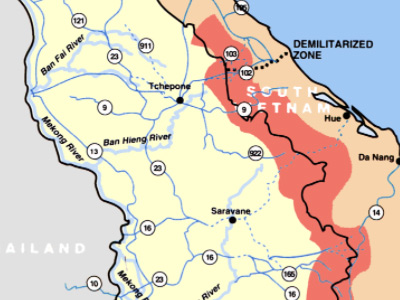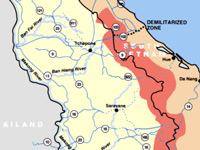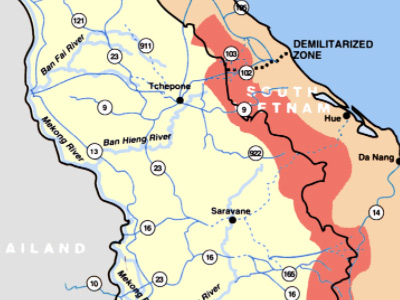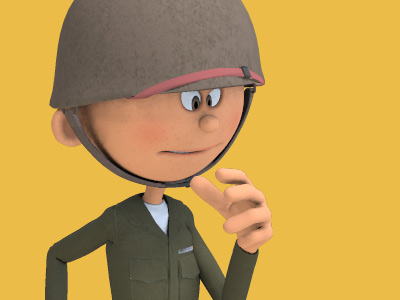Vietnam War (1955–1975)

Kennedy's Escalation, 1961–63
In the 1960 U.S. presidential election, Senator John F. Kennedy defeated incumbent Vice President Richard Nixon. Although Eisenhower warned Kennedy about Laos and Vietnam, Europe and Latin America "loomed larger than Asia on his sights." In his inaugural address, Kennedy made the ambitious pledge to "pay any price, bear any burden, meet any hardship, support any friend, oppose any foe, in order to assure the survival and success of liberty." In June 1961, he bitterly disagreed with Soviet premier Nikita Khrushchev when they met in Vienna to discuss key U.S.–Soviet issues. Only 16 months later, the Cuban Missile Crisis (16–28 October 1962) played out on television worldwide. It was the closest the Cold War came to escalating into a full-scale nuclear war, and the United States The United States of America (U.S.A. or USA), commonly known as the United States (U.S. or US) or America, is a country in North America. It is the world's third-largest country by both land and total area. The United States shares land borders with Canada to its north and with Mexico to its south. The national capital is Washington, D.C., and the most populous city and financial center is New York City. raised the readiness level of Strategic Air Command (SAC) forces to DEFCON 2.
The United States of America (U.S.A. or USA), commonly known as the United States (U.S. or US) or America, is a country in North America. It is the world's third-largest country by both land and total area. The United States shares land borders with Canada to its north and with Mexico to its south. The national capital is Washington, D.C., and the most populous city and financial center is New York City. raised the readiness level of Strategic Air Command (SAC) forces to DEFCON 2.
The Kennedy administration remained essentially committed to the Cold War foreign policy inherited from the Truman and Eisenhower administrations. In 1961, the U.S. had 50,000 troops based in Korea, and Kennedy faced a three-part crisis – the failure of the Bay of Pigs Invasion, the construction of the Berlin Wall, and a negotiated settlement between the pro-Western government of Laos and the Pathet Lao communist movement. These crises made Kennedy believe that another failure on the part of the United States to gain control and stop communist expansion would fatally damage U.S. credibility with its allies and his own reputation. Kennedy was thus determined to "draw a line in the sand" and prevent a communist victory in Vietnam. He told James Reston of The New York Times immediately after his Vienna meeting with Khrushchev, "Now we have a problem making our power credible and Vietnam looks like the place."
In May 1961, U.S. Vice President Lyndon B. Johnson visited Saigon and enthusiastically declared Diệm the "Winston Churchill of Asia." Asked why he had made the comment, Johnson replied, "Diệm's the only boy we got out there." Johnson assured Diệm of more aid in molding a fighting force that could resist the communists.
Kennedy's policy toward South Vietnam rested on the assumption that Diệm and his forces had to ultimately defeat the guerrillas on their own. He was against the deployment of American combat troops and observed that "to introduce U.S. forces in large numbers there today, while it might have an initially favorable military impact, would almost certainly lead to adverse political and, in the long run, adverse military consequences." The quality of the South Vietnamese military, however, remained poor. Poor leadership, corruption, and political promotions all played a part in weakening the South Vietnamese Army (ARVN). The frequency of guerrilla attacks rose as the insurgency gathered steam. While Hanoi's support for the Viet Cong played a role, South Vietnamese governmental incompetence was at the core of the crisis.
One major issue Kennedy raised was whether the Soviet Soviet Union, officially the Union of Soviet Socialist Republics (USSR), was a transcontinental country that spanned much of Eurasia from 1922 to 1991. The Soviet Union fall process began with growing unrest in the Union's various constituent national republics developing into an incessant political and legislative conflict between them and the central government. Estonia was the first Soviet republic to declare state sovereignty inside the Union. space and missile programs had surpassed those of the United States. Although Kennedy stressed long-range missile parity with the Soviets, he was also interested in using special forces for counterinsurgency warfare in Third World countries threatened by communist insurgencies. Although they were originally intended for use behind front lines after a conventional Soviet invasion of Europe, Kennedy believed that the guerrilla tactics employed by special forces such as the Green Berets would be effective in a "brush fire" war in Vietnam.
Soviet Union, officially the Union of Soviet Socialist Republics (USSR), was a transcontinental country that spanned much of Eurasia from 1922 to 1991. The Soviet Union fall process began with growing unrest in the Union's various constituent national republics developing into an incessant political and legislative conflict between them and the central government. Estonia was the first Soviet republic to declare state sovereignty inside the Union. space and missile programs had surpassed those of the United States. Although Kennedy stressed long-range missile parity with the Soviets, he was also interested in using special forces for counterinsurgency warfare in Third World countries threatened by communist insurgencies. Although they were originally intended for use behind front lines after a conventional Soviet invasion of Europe, Kennedy believed that the guerrilla tactics employed by special forces such as the Green Berets would be effective in a "brush fire" war in Vietnam.
Kennedy advisors Maxwell Taylor and Walt Rostow recommended that U.S. troops be sent to South Vietnam disguised as flood relief workers. Kennedy rejected the idea but increased military assistance yet again. In April 1962, John Kenneth Galbraith warned Kennedy of the "danger we shall replace the French France, officially the French Republic is transcontinental country predominantly located in Western Europe and spanning overseas regions and territories in the Americas and the Atlantic, Pacific and Indian Oceans. France reached its political and military zenith in the early 19th century under Napoleon Bonaparte, subjugating much of continental Europe and establishing the First French Empire. as a colonial force in the area and bleed as the French did." By November 1963, there were 16,000 American military personnel in South Vietnam, up from Eisenhower's 900 advisors.
France, officially the French Republic is transcontinental country predominantly located in Western Europe and spanning overseas regions and territories in the Americas and the Atlantic, Pacific and Indian Oceans. France reached its political and military zenith in the early 19th century under Napoleon Bonaparte, subjugating much of continental Europe and establishing the First French Empire. as a colonial force in the area and bleed as the French did." By November 1963, there were 16,000 American military personnel in South Vietnam, up from Eisenhower's 900 advisors.
The Strategic Hamlet Program was initiated in late 1961. This joint U.S.-South Vietnamese program attempted to resettle the rural population into fortified camps. It was implemented in early 1962 and involved some forced relocation, village internment, and segregation of rural South Vietnamese into new communities where the peasantry would be isolated from Communist insurgents. It was hoped these new communities would provide security for the peasants and strengthen the tie between them and the central government. However, by November 1963 the program had waned, and it officially ended in 1964.
On 23 July 1962, fourteen nations, including China, South Vietnam, the Soviet Union, North Vietnam and the United States, signed an agreement promising to respect the neutrality of Laos.
Ousting and Assassination of Ngô Đình Diệm
The inept performance of the South Vietnamese army was exemplified by failed actions such as the Battle of Ap Bac on 2 January 1963, in which a small band of Viet Cong won a battle against a much larger and better-equipped South Vietnamese force, many of whose officers seemed reluctant even to engage in combat.
The Army of the Republic of Vietnam forces were led in that battle by Diệm's most trusted general, Huỳnh Văn Cao, commander of the IV Corps. Cao was a Catholic who had been promoted due to religion and fidelity rather than skill, and his main job was to preserve his forces to stave off coups; he had earlier vomited during a communist attack. Some policymakers in Washington began to conclude that Diệm was incapable of defeating the communists and might even make a deal with Ho Chi Minh. He seemed concerned only with fending off coups, and had become more paranoid after attempts in 1960 and 1962, which he partly attributed to U.S. encouragement. As Robert F. Kennedy noted, "Diệm wouldn't make even the slightest concessions. He was difficult to reason with ..."
As historian James Gibson summed up the situation:
Strategic hamlets had failed ... The South Vietnamese regime was incapable of winning the peasantry because of its class base among landlords. Indeed, there was no longer a 'regime' in the sense of a relatively stable political alliance and functioning bureaucracy. Instead, civil government and military operations had virtually ceased. The National Liberation Front had made great progress and was close to declaring provisional revolutionary governments in large areas.
Discontent with Diệm's policies exploded following the Huế Phật Đản shootings of nine majority Buddhists who were protesting against the ban on the Buddhist flag on Vesak, the Buddha's birthday. This resulted in mass protests against discriminatory policies that gave privileges to the Catholic Church and its adherents. Diệm's elder brother Ngô Đình Thục was the Archbishop of Huế and aggressively blurred the separation between church and state. Thuc's anniversary celebrations shortly before Vesak had been bankrolled by the government, and Vatican flags were displayed prominently. There had also been reports of Buddhist pagodas being demolished by Catholic paramilitaries throughout Diệm's rule. Diệm refused to make concessions to the Buddhist majority or take responsibility for the deaths. On 21 August 1963, the ARVN Special Forces of Colonel Lê Quang Tung, loyal to Diệm's younger brother Ngô Đình Nhu, raided pagodas across Vietnam, causing widespread damage and destruction and leaving a death toll estimated to range into the hundreds.
U.S. officials began discussing the possibility of a regime change during the middle of 1963. The United States Department of State was generally in favor of encouraging a coup, while the Defense Department favored Diệm. Chief among the proposed changes was the removal of Diệm's younger brother Nhu, who controlled the secret police and special forces and was seen as the man behind the Buddhist repression and more generally the architect of the Ngô family's rule. This proposal was conveyed to the U.S. embassy in Saigon in Cable 243.
The Central Intelligence Agency (CIA) was in contact with generals planning to remove Diệm. They were told that the United States would not oppose such a move nor punish the generals by cutting off aid. President Diệm was overthrown and executed, along with his brother, on 2 November 1963. When Kennedy was informed, Maxwell Taylor remembered that he "rushed from the room with a look of shock and dismay on his face." He had not anticipated Diệm's murder. The U.S. ambassador to South Vietnam, Henry Cabot Lodge, invited the coup leaders to the embassy and congratulated them. Ambassador Lodge informed Kennedy that "the prospects now are for a shorter war". Kennedy wrote Lodge a letter congratulating him for "a fine job".
Following the coup, chaos ensued. Hanoi took advantage of the situation and increased its support for the guerrillas. South Vietnam entered a period of extreme political instability, as one military government toppled another in quick succession. Increasingly, each new regime was viewed by the communists as a puppet of the Americans; whatever the failings of Diệm, his credentials as a nationalist (as Robert McNamara later reflected) had been impeccable.
U.S military advisors were embedded at every level of the South Vietnamese armed forces. They were however criticized for ignoring the political nature of the insurgency. The Kennedy administration sought to refocus U.S. efforts on pacification and "winning over the hearts and minds" of the population. The military leadership in Washington, however, was hostile to any role for U.S. advisors other than conventional troop training. General Paul Harkins, the commander of U.S. forces in South Vietnam, confidently predicted victory by Christmas 1963. The CIA was less optimistic, however, warning that "the Viet Cong by and large retain de facto control of much of the countryside and have steadily increased the overall intensity of the effort".
Paramilitary officers from the CIA's Special Activities Division trained and led Hmong tribesmen in Laos and into Vietnam. The indigenous forces numbered in the tens of thousands and they conducted direct action missions, led by paramilitary officers, against the Communist Pathet Lao forces and their North Vietnamese supporters. The CIA also ran the Phoenix Program and participated in Military Assistance Command, Vietnam – Studies and Observations Group (MAC-V SOG), which was originally named the Special Operations Group, but was changed for cover purposes.
HISTORY

RESOURCES
This article uses material from the Wikipedia article "Vietnam War (1955–1975)", which is released under the Creative Commons Attribution-Share-Alike License 3.0.
© Stories Preschool. All Rights Reserved.









